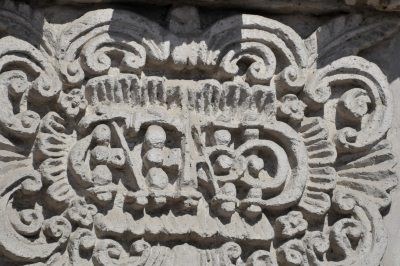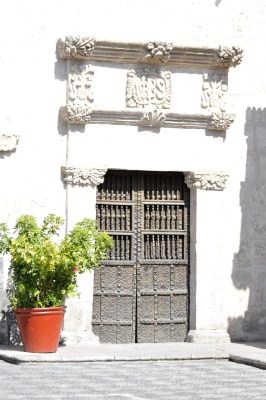Arequipa

|
Arequipa
Arequipa is the capital city of the Arequipa Region in southern Peru. With a population of about nine hundred thousand it is the second most populous city of the country. Arequipa lies in the Andes Mountains, at an altitude of seven thousand, eight hundred feet above sea level. Arequipa is six hundred and sixty three, point eight miles from Lima. Located at sixteen degrees, twenty three minutes, point five five South. Seventy one degrees, thirty two minutes, point one two West. The city has many colonial-era Spanish buildings built of sillar, a pearly white volcanic rock, from which it gets the nickname La Ciudad Blanca ("The White City"). It first acquired this nickname in the colonial era, because most of its inhabitants were Creole of peninsular (Spanish) descent. The historic centre of Arequipa was named a UNESCO World Heritage Site in 2000, in recognition of its architecture and historic integrity. “The historic centre of Arequipa is an example of ornamental architecture, representing a masterpiece of the European creative coalition and native characteristics.” “A colonial village challenged by the conditions of nature, indigenous influence, the process of conquest and evangelisation as well as spectacular natural scenery.” Soon after its founding, the city became the major commercial hub of southern Peru, with commercial and administrative functions. The city became "Capital of the Republic" during the government of Montero. Arequipa has also been home of many of the outstanding intellectual figures, political and religious icons in the country. In recent decades it has become an important industrial and commercial centre of Peru, now being the second most industrialised city. It has several industrial parks, with close trade ties to Chile, Bolivia and Brazil; links with cities connected by the Southern Railway and with the port of Matarani. Thomas Love described the city as a cultural oasis and natural beauty. Arequipa is Peru's second largest city and was founded in 1540. The site was chosen for its proximity to the coast, enabling settlers to trade the products of Cuzco and the mines of Potosi (Bolivia) with Lima. The local cultivation of wheat, corn and grapes all contributed to the region’s economic growth.
 History: The Incas believed Cuzco to be the centre of the world. They referred to the area of Arequipa as the "land or place behind the volcanoes", or other location behind the mountains, or ariq qipao. During the 15th century, the region was occupied by the Aymaras, conquered by the Incas and served as an important provider of agricultural products for the Inca Empire. El Misti is a snow-capped volcano currently inactive, (strong eruptions 1438 and 1471) at 19,101 feet. It rises between the extinct volcanoes of Chachani – 19,931 feet and Picchu Picchu – 18,228 feet, Quechua names. Incas highly respected these volcanoes since the melt water from their snow-capped peaks form the headwaters of the mighty Amazon River, thousands of miles away. Arequipa has more than eighty volcanoes in the aptly named - Valley of the Volcanoes. Unfortunately the city was built on a very earthquake prone area and was completely destroyed by earthquakes and volcanic eruptions during the 1600’s. On the feast day of the Virgin of the Assumption, the 15th of August 1540, Lieutenant Governor Garci Manuel de Carbajal (an emissary of the conqueror Francisco Pizarro), founded the Villa de la Asuncion de Nuestra Señora del Valle Hermoso de Arequipa by on the left bank of the River Chili. A year later King Charles V of Spain gave it the rank of city and the coat of arms that still remains. On the 21st of July 1821, Don José de San Martin declared Peru’s independence from the Spanish colony, and during the 19th century Arequipa housed many Peruvian nationalists. During this period Arequipa became known across the continent as a land of leaders and for the courage of the Arequipenan rebels. The White City of Arequipa has become the centre of economic growth in the south and is one of the most important milk producers in the country. This has allowed Arequipa to develop and grow in population and change over the years. In the mid-twentieth century there was an influx of immigrants from the highlands and mountain areas, now Arequipa’s population is a mixture of Spanish, indigenous and mixed.
  Industry: Arequipa Industrial Park has over one hundred and fifty companies -: Alicorp SAA, Processed Foods SA, Laive, La Iberica, Manuel Muñoz Najar, Bin Pan SA, Consorcio Industrial Arequipa SA, Omniagro, Backus & Johnston, Corporación Aceros Arequipa to name but a few. Arequipa has a well developed cotton textile industry with alpaca and wool factories such as Francky and Ricky, Michell & Cia. and IncaTops.
  Climate: The climate of Arequipa is especially warm and rather dry, all through the year. Arequipa lies alongside the southernmost tip of Peru's Desert Coast and enjoys plenty of sunny weather, with daytime temperatures rarely dipping much below twenty degrees centigrade. At night, temperatures can drop sharply, particularly in June, July and August, when evening temperatures hover around ten degrees centigrade and can feel quite chilly.
  Tourism: Tourism is an important economic factor for the city, the third most visited in Peru after Lima and Cuzco. In 2008, 1,217,254 people visited Arequipa, 290,983 of which were foreign. People who visit this city can admire the colonial architecture in the historic centre of Arequipa, the magnificent Inca terraces in the countryside surrounding districts and a very extensive landscape, the product of human and natural creation, an important factor in its declaration as Cultural Heritage Humanity.
Historical Architecture: The great earthquakes marked milestones in the formation of the architecture of Arequipa in five periods: Founding and villager (1540-1582), Splendor of Baroque (1582-1784), Rococo and Neoclassical Reviews (1784-1868), Empiricism, Modernising and Neo colonial (1868-1960) and contemporary.
 
Arequipa Attractions: Arequipa's Plaza de Armas is one of the most beautiful in Peru. On the north side of the Plaza is the impressive, twin-towered Cathedral, founded in 1612 and largely rebuilt in the 19th Century having been repeatedly damaged by earthquakes and fire. Inside is fine Belgian organ and elaborately-carved wooden pulpit. The Plaza is surrounded on its other three sides by colonial arcaded buildings with many cafes and restaurants. Behind the Cathedral is a pretty back street with many handicraft shops.
 ALL IN ALL AN ATTRACTIVE CITY WITH A VERY SPANISH
FEEL A UNIQUELY WHITE, PRETTY
CITY |


